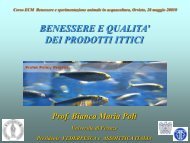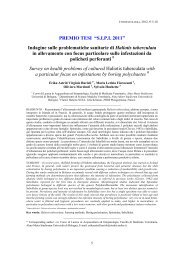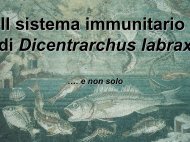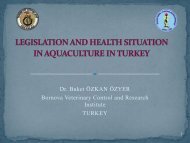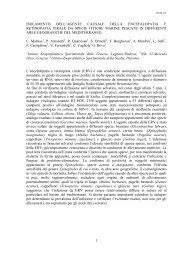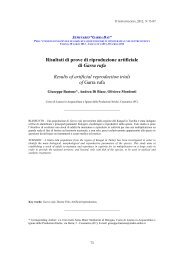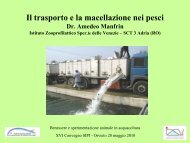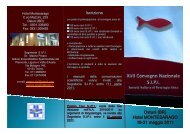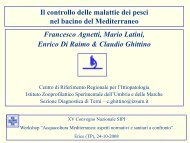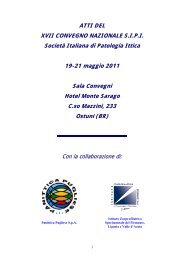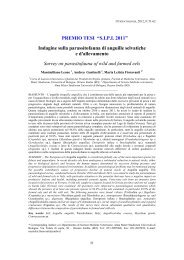ATTI DEL XV CONVEGNO NAZIONALE SIPI Società Italiana di ...
ATTI DEL XV CONVEGNO NAZIONALE SIPI Società Italiana di ...
ATTI DEL XV CONVEGNO NAZIONALE SIPI Società Italiana di ...
- No tags were found...
Create successful ePaper yourself
Turn your PDF publications into a flip-book with our unique Google optimized e-Paper software.
Abstract Workshop<br />
AQUATIC ORGANISM LEGISLATION ACCORDING TO 2006/88/EC<br />
DIRECTIVE<br />
Giuseppe BOVO<br />
Istituto Zooprofilattico Sperimentale delle Venezie, Viale dell’Università, 10 - 35020<br />
Legnaro (PD), ITALY.<br />
By August 2008 all European MS should have implemented in their own legislation the<br />
<strong>di</strong>rective 2006/88/CE “on animal health requirements for aquaculture animals and<br />
products thereof, and on the prevention and control of certain <strong>di</strong>seases in aquatic<br />
animals”. This recent <strong>di</strong>rective repeals the existing ones 91/67/EEC, 93/53/EEC and<br />
95/70/EC while 2004/453/EC shall continue to apply for the purpose of this Directive<br />
pen<strong>di</strong>ng the adoption of the necessary provisions.<br />
Fish, molluscs and Crustacea have been included in a common document in order to<br />
harmonize the general control methods and apply the same approach whenever possible.<br />
Accor<strong>di</strong>ng to a shared strategy it is important to ensure that the main aquatic animal<br />
<strong>di</strong>seases do not spread from originally infected areas to free areas. Harmonised animal<br />
health provisions for placing on the market of aquatic animals have been therefore laid<br />
down and a list of important fish, mollusc and Crustacea <strong>di</strong>seases and species susceptible<br />
thereto have been adopted.<br />
In order to ensure early detection of any possible outbreak of animal <strong>di</strong>sease, those persons<br />
in contact with aquatic animals of susceptible species will be obliged to notify any suspect<br />
case of <strong>di</strong>sease to the competent authority. Furthermore routine inspections and samplings<br />
have been foreseen in all the farms, particularly those rearing susceptible species, in order<br />
to ensure that aquaculture production business operators may become familiar with, and<br />
apply, the general rules on <strong>di</strong>sease control and biosecurity laid down in the <strong>di</strong>rective.<br />
The definition of farm and zones, identified on geographical basis and already consolidated<br />
during the past legislation, has been maintained while a new epidemiological unit has been<br />
introduced. In fact the Compartment is a new epidemiological unit consisting of one farm<br />
or more farms under a common biosecurity system containing an aquatic animal<br />
population with a <strong>di</strong>stinct health status with respect to a specific <strong>di</strong>sease.<br />
To enhance the animal health status of the Community, epidemiologically based<br />
programmes to control and era<strong>di</strong>cate certain <strong>di</strong>seases have been foreseen and they should<br />
be adopted at MS or Community level.<br />
Because of the importance of the analytical results on control programs the laboratories<br />
involved in the examination of official samples must work in accordance with<br />
internationally approved procedures or criteria based on performance standards and must<br />
use <strong>di</strong>agnostic methods that have, as far as possible, been validated. In ad<strong>di</strong>tion they have<br />
to participate to the proficiency tests regularly organized by the Community Reference<br />
Laboratory and obtain a positive score.<br />
Attention has been paid on import of live animals which should have at least the same<br />
health status of the area where they are introduced. Ornamental fish for which an important<br />
trade exists do not pose a high risk except if they are kept outside closed systems or<br />
aquariums, in <strong>di</strong>rect contact with the natural waters as the case of koi carps. In this case<br />
they are compared to other farmed species and included in the <strong>di</strong>rective.<br />
64



